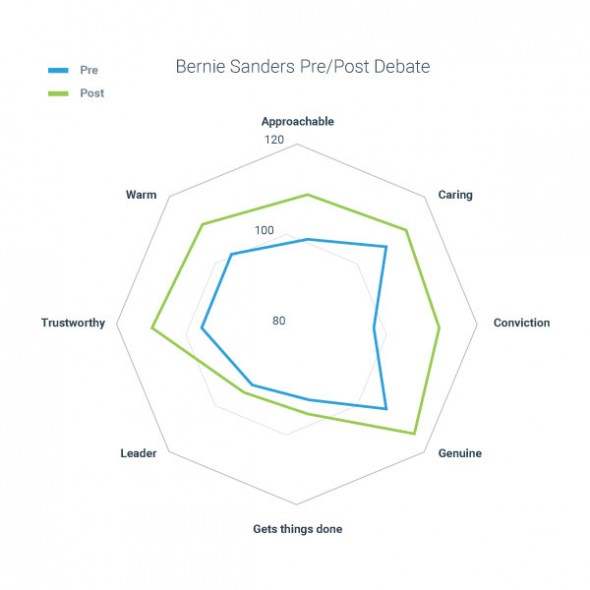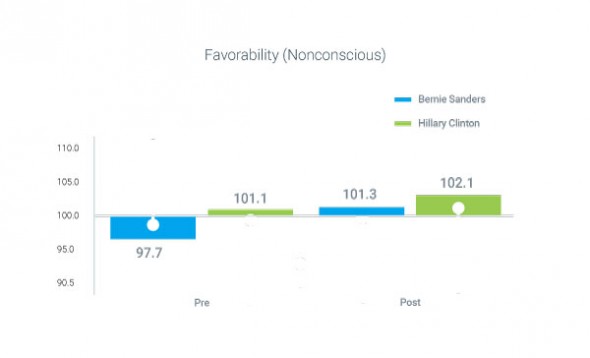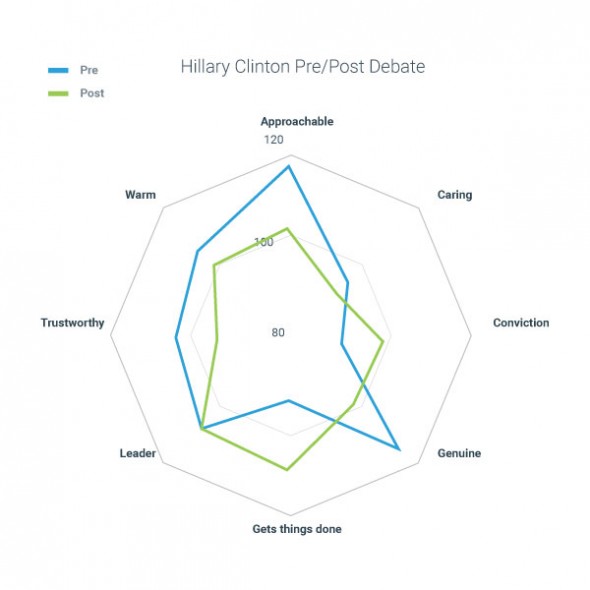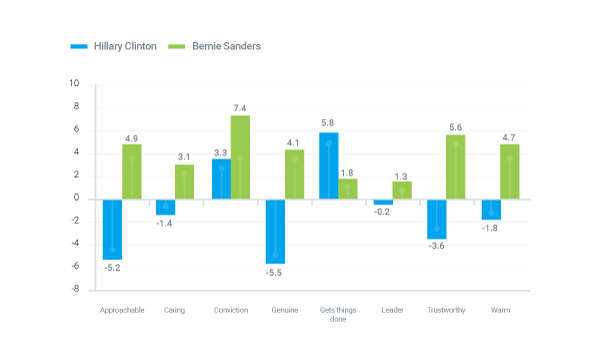Post-Debate Subconscious Perceptions of Hillary vs. Bernie: Implicit Association Test Results
Or has she?
While Bill Clinton (with his “Wow, wow, wow!” email to supporters this morning) and the traditional media outlets seem to have no qualms about proclaiming Hillary as the winner by a long shot, internet polls and the Twitter-verse seem to be saying something very different.
So what’s the story? Who really won the Democratic debate: Bernie Sanders or Hillary Clinton?
Subconscious Perceptions of Hillary and Bernie: Pre and Post Debate
We ran implicit association tests using Sentient Prime® to analyze subconscious associations with the two candidates directly before and directly after the debate. Over 1,000 people from across the U.S. participated in the online study. Here’s what America’s subconscious is telling us:
The data show a significant overall ‘halo’ effect for Bernie Sanders on eight key attribute associations. Sanders saw significant boosts in positive assocations within the general population.
This was in sharp contrast to Hillary Clinton who saw a positive impact on only three of the eight attribute associations tested.

For Bernie, this debate is a win.
The true non-conscious data show that the national exposure to his message and demeanor were positively perceived, potentially broadening his appeal beyond the viscerally charged and vociferous crowds he wows at rallies.
Notable Rise in Implicit Favorability for Bernie Sanders
This was notable in the rise in his implicit favorability (five point rise pre-debate to post-debate) compared to just a one point rise in implicit favorability for Clinton. But perhaps these results are not surprising, given that this is the first real national stage that has featured Bernie Sanders as a realistic presidential candidate.
We would expect overall boosts in favorability from a neutral/unknown position as long as has was positively perceived (which the data indicate he was).

For Clinton, the challenge is different, given that she has been on the national stage for more than 20 years, and these results provide important insight given her position. According to many traditional media reports this morning, she was the hands-down winner of the debate.
Hillary Clinton Showcases Her Political Brand: Leader, Conviction, Efficient
These results show more nuance to her performance. Clinton made an important impact on the non-conscious associations of “getting things done”, “leader”, and “conviction” with her political brand through her debate performance.
However, these gains were potentially at the sacrifice of non-conscious associations of her being “approachable.”

In order to determine whether these changes in implicit associations are enough to declare a win for Hillary, we need to consider the entire campaign communications strategy.
Effacacy of the Candidates’ Campaign Communications Strategies
Recent appearances on late-night social media friendly outlets (like SNL and Ellen) have made important in-roads on increasing perceptions of her “approachability” (as evidenced in her pre-debate approachability implicit associations).
However, the debate format, and the apparent campaign objectives for this debate: to communicate a “polished, practical, “get-things-done progressive” image while not alienating the liberal base (so energized by Sanders’ palpable passion) suggests that making non-conscious impact on associations of “conviction”, “gets things done” and “leader” might be the perfect outcome for this candidate.
Of course we don’t need to rely on conjecture to determine if these lifts matter for the campaign. Sentient Prime implicit association testing produces quantitative data at the individual level that can be used to statistically determine the importance of changes in non-conscious associations.
What Do Voters Care About?
We ran a regression on derived voter preference for Hillary, using the implicit associations as predictors. The results showed that “leader” emerged as the strongest driver of voter preference, and it was highly correlated with “conviction,” p = .05.
Notably, “approachable” was the second strongest driver for preference for Hillary indicating an important nuance for the campaign’s communication strategy. So while this platform offered great opportunity for Clinton to differentiate from Sanders in leadership, the results indicate a need to balance approachability with the clear conviction she has for voter values.
These results are telling. Bernie made important overall gains in positive reception of his candidacy. But Hillary, in a tougher position of influencing perception of a national voter base whom has known her for more than two decades, made important gains on attributes that are critical to her election potential.

Clinton Made Impact Where it Matters
Maybe Bill Clinton’s email to supporters this morning was right. Implicitly, Hillary made the impact where she needed to–making gains on Bernie on passion, and leading Bernie on getting things done.
Is this the recipe for the rest of the primary season? Collective campaign strategic response will tell–and you can count on Sentient Prime to quantify the implicit impact on voter preference.
